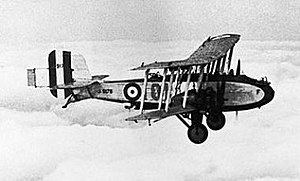Top speed 224 km/h Length 14 m Retired 1936 | Wingspan 22 m Introduced 1928 Manufacturer Boulton Paul Aircraft | |
 | ||
The Boulton Paul P.29 Sidestrand was a twin-engine biplane medium bomber of the Royal Air Force. Named after a village on the Norfolk coast near Boulton & Paul's factory in Norwich, the Sidestrand first flew in 1926 and entered service in 1928. It remained in service until 1936, equipping No. 101 Squadron RAF. It was an agile and relatively fast aircraft that was capable of aerobatic manoeuvres such as loops, rolls and spins.
Contents
Design and development
Boulton & Paul Ltd of Norwich built a series of twin-engined biplanes starting with the Bourges of 1918, which although not ordered into production, had demonstrated excellent performance and manoeuvrability, followed by the all-metal Bolton of 1922 and the smaller Bugle of 1923. In 1924, the Air Ministry issued Specification 9/24 for an all-metal, twin engined medium bomber, with an order for two prototypes following early in 1925. The first aircraft flew in 1926, piloted by C. A. Rea, Boulton & Paul's first full-time test pilot.
The village of Sidestrand, chosen for the aircraft name, was the home of the Secretary of State for Air, Samuel Hoare Only 20 Sidestrands were built, the first two being equivalent prototypes, were called the Sidestrand Mk I. Originally intended to be powered by two Napier Lion inline engines, the Mk I was eventually fitted with 425 hp (317 kW) Bristol Jupiter VI radial engines, which also powered the first six production Sidestrands, known as the Sidestrand Mk II. The remaining twelve aircraft were powered by 460 hp (343 kW) Jupiter VIIFs as the Sidestrand Mk III. The six Mk IIs were re-engined to bring them up to the Mk III specification.
The Sidestrand had three open gun positions; nose, dorsal and ventral. There was usually a crew of three; pilot, nose gunner and a gunner for the dorsal or ventral positions, the choice depending on where each aircraft flew in a formation. Armament for each position was a .303 in (7.7 mm) Lewis gun, the gun being moved between the two rear positions as required. The Sidestrand bomb-load was limited to 1,050 pounds (480 kg), less than contemporaries such as the Tupolev TB-1.
Operational history
Deliveries to the re-formed No. 101 Squadron at Bircham Newton began in 1928, the first batch of six aircraft being the Sidestrand Mk II with un-geared Bristol Jupiter VI engines. These were followed by nine Sidestrand Mk III variants with geared Jupiter VIII Fs and the final three production aircraft were replacement Mk IIs. The squadron moved to RAF Andover in 1929.
The Sidestrand inherited the good manoeuvrability of the Boulton Paul P. 7 Bourges, but despite proving to be an excellent aircraft for bombing and gunnery, only No. 101 Squadron was so equipped. In the early 1930s a Sidestrand Mk III was fitted with Bristol Pegasus IM3 engines. This was intended to become the Sidestrand Mk IV, but eventually became the prototype for the redeveloped Boulton Paul Overstrand which would begin replacing the Sidestrand in service in 1936. Four Sidestrands were eventually converted to Overstrand standard and are essentially considered Overstrands.
Variants
Operators
Specifications (Mk III)
Data from The British Bomber since 1914
General characteristics
Performance
Armament
